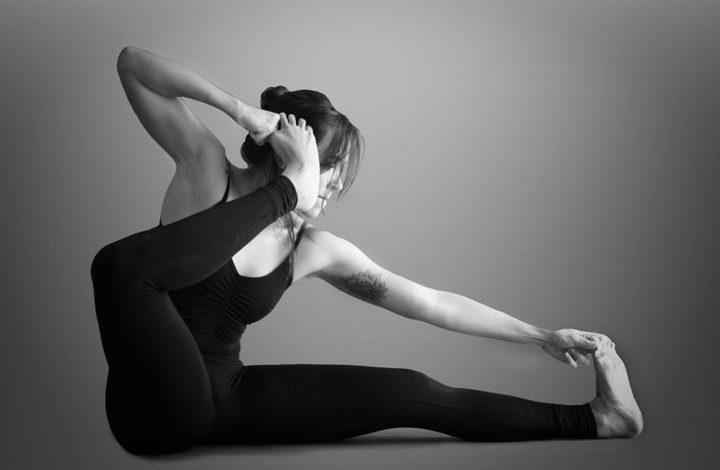Take Aim at Inner Peace and Strength with Akarna Dhanurasana: A Step-by-Step Guide and Benefits

Akarna Dhanurasana, also known as the Archer Pose or Shooting Bow Pose, is a yoga posture that has significant benefits for both the body and mind. It is an intermediate-level posture that requires strength, flexibility, and concentration. The pose is named after the bow and arrow used by archers in ancient India, symbolizing the focused concentration and power needed to hit the target. In this article, we will explore the benefits, preparation, and steps for performing Akarna Dhanurasana, as well as tips for practicing it safely. Whether you are a beginner or an experienced yogi, adding Akarna Dhanurasana to your practice can help you cultivate strength, focus, and balance both on and off the mat.
And if you also want to learn different types of yoga asanas, then you should join a 300 hour yoga teacher training in Rishikesh.
I. Benefits of Akarna Dhanurasana
Akarna Dhanurasana offers a variety of physical, mental, and emotional benefits for practitioners. Here are some of the key benefits of this posture:
- Strengthens the legs, back, and arms Akarna Dhanurasana requires you to hold your leg with your hands and keep your back upright, which strengthens your leg muscles, back muscles, and arm muscles.
- Improves digestion and blood circulation The compression of the abdomen and the stretching of the legs in this pose can help stimulate the digestive system and improve blood circulation in the lower body.
- Relieves stress and anxiety The deep breathing and meditative focus required in this posture can help calm the mind, reduce stress, and alleviate anxiety.
- Enhances focus and concentration The concentration required to maintain balance and hold the pose can help improve mental focus and concentration.
II. Preparatory Poses for Akarna Dhanurasana
Before attempting Akarna Dhanurasana, it’s helpful to warm up and stretch the muscles in your legs, back, and arms. Here are some preparatory poses that can help you build the necessary strength and flexibility:
- Ardha Navasana (Half Boat Pose) This pose strengthens the abdominal muscles and helps you develop the core strength needed to hold the Archer Pose.
- Ustrasana (Camel Pose) This pose stretches the front of the body, including the thighs, abdomen, and chest, preparing you for the backbend in Akarna Dhanurasana.
- Paschimottanasana (Seated Forward Bend) This pose stretches the hamstrings and lower back, helping you to develop the flexibility needed to reach your toes in Akarna Dhanurasana.
III. Step-by-Step Guide to Performing Akarna Dhanurasana
Here’s a step-by-step guide to performing Akarna Dhanurasana:
- Start by sitting on the floor with your legs stretched out in front of you.
- Bend your left knee and bring your heel towards your perineum.
- Hold onto your left foot with your left hand and reach your right arm around your back to hold onto your left hand.
- Inhale and lift your chest towards the sky, lengthening your spine.
- Exhale and gently pull on your left foot with your left hand, lifting your left leg off the ground.
- Hold the pose for a few breaths, keeping your back straight and your gaze forward.
- Now release the pose and repeat on the other side.
IV. Tips for Practicing Akarna Dhanurasana Safely
Here are some tips for practicing Akarna Dhanurasana safely and effectively:
- Listen to your body and respect your limits: When practicing Akarna Dhanurasana, it’s very important to listen to your body and respect your limitations. Don’t push yourself too hard, especially if you’re a beginner, and always work within your range of motion. Be mindful of any pain or discomfort you may experience and back off or modify the pose if needed.
- Warm up properly before attempting the pose: Warming up your body before attempting Akarna Dhanurasana is crucial to prevent injury and prepare your muscles and joints for the posture. Consider doing some gentle stretches, such as seated forward folds or gentle twists, to warm up your back, hips, and legs.
- Use props, such as blocks or straps, to help you reach your foot if needed: If you’re not able to reach your foot with your hand, consider using props such as blocks or straps to help you reach your foot. Place a block under your foot or use a strap to loop around your foot and hold onto it with your hand.
- Avoid this posture if you have any injuries or conditions that affect your back or legs: If you have any injuries or conditions that affect your back or legs, such as sciatica or herniated discs, it’s best to avoid this posture. Speak to your yoga teacher or a healthcare professional before attempting Akarna Dhanurasana if you have any concerns.
By following these tips, you can practice Akarna Dhanurasana safely and effectively, and avoid any potential injuries or discomfort. Remember that yoga is a journey, and it’s important to take your time and enjoy the process of exploring the poses.
V. Conclusion
Incorporating Akarna Dhanurasana into your yoga practice can help you build strength, flexibility, and concentration, while also providing a sense of calm and balance. By following these tips and taking the time to prepare properly, you can safely explore the benefits of this powerful posture. So grab your bow and arrow, and take aim at your inner peace and strength with Akarna Dhanurasana!
In conclusion, Akarna Dhanurasana is a challenging posture that offers a range of benefits for the body, mind, and spirit. By strengthening the legs, back, and arms, improving digestion and blood circulation, relieving stress and anxiety, and enhancing focus and concentration, this posture can help you cultivate greater physical and mental well-being. However, it’s important to approach the pose with caution and respect for your body’s limitations. By warming up properly, using props if needed, and avoiding posture if you have any injuries or conditions that affect your back or legs, you can practice Akarna Dhanurasana safely and effectively.
With consistent practice and patience, you can deepen your understanding of this posture and develop the strength, flexibility, and concentration needed to hit the target of inner peace and balance. So why not give Akarna Dhanurasana a try in your next yoga session and see how it can enhance your practice and your life?





